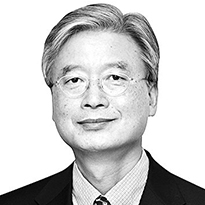[Column] Preparing for the Asia century

Cho Yoon-je
The author is professor emeritus at Sogang University and a member of the Monetary Policy Board of the Bank of Korea.
The definition and boundaries of Asia are unclear. The region has been called Asia since ancient Greece. Greek historian and geographer Hecataeus defined that the world consisted of Europe, Asia and Africa. But Asia he was referring to is modern-day Turkey and Iran east of the Aegean Sea. It is now a region called Asia Minor. Since then, dividing Eurasia into Europe and Asia has been mainly determined by Europeans.
Today, the vast area to the east of the Urals and the Suez Canal is considered Asia. The British called their largest colony India “East,” meaning Asia, and called the area further to the east “the Far East.” In contrast, Americans have perceived Asia as East Asia beyond the Pacific Ocean. Koreans generally refer to India, its neighbors and countries to the east of India as Asia.
Asia is on the rise. Since the Renaissance, Europe showed high economic growth thanks to its technological and institutional developments, and after the acceleration of the Industrial Revolution, Europe and the U.S. led global economic growth until the first half of the 20th century. As a result, many Asian countries fell victim to colonialism. China also was semi-colonized. But the growth engine of the global economy led by the West for five to six centuries began to shift to Asia in the latter half of the 20th century. Global media and think tanks now believe the 21st century will be the “century of Asia.”
Currently, Asia has a population of 4.7 billion, accounting for 60 percent of the world’s population. China and India make up over 36 percent of the world’s population. The combined population of Indonesia, Pakistan, Bangladesh and Japan is more than 10 percent of the world’s population. On the other hand, the total population of the United States and Europe is less than 14 percent.
PwC, a global consulting firm, predicted that by 2050, China will have the largest economy, followed by India, the U.S. and Indonesia. Asia is expected to account for half the world’s GDP, and the size of its economy will more than double that of the U.S. and Europe combined. Korea is expected to be the 18th largest economy, followed by the Philippines at 19th and Vietnam at 20th.
According to Mauro Guillen’s “2030: How Today’s Biggest Trends Will Collide and Reshape the Future of Everything (2020),” the purchasing power of the middle class in Asia will account for over 60 percent of the global average middle-class purchasing power. That’s because the average age of the Asian population is far younger that those of the U.S. and European populations.
But still, the world’s political and economic order is being led by the U.S. and Europe. According to the most recent statistics, the United States accounts for 24 percent of the world’s GDP, and Europe accounts for 22 percent, far exceeding China’s 17 percent and India’s 3 percent. But by 2050, the ranking in purchasing power will be reversed, with China taking up 20 percent, India 15 percent, the U.S. 12 percent and Europe 9 percent. It is a good indication of how fast and overwhelming Asia’s rise will be.
Will the 21st century really be the century of Asia? It is almost certain in terms of the size of the economy. Yet it is unclear whether Asia will lead the world order in the 21st century. The gap with the West is still huge, especially in terms of intellectual leadership and the ability to run international organizations. For instance, the Group of 7 countries have a 43 percent stake in the International Monetary Fund, followed by the U.S. at 17 percent which leads the IMF’s policy and operation. The G7’s share of the global economy is anticipated to fall to 20 percent by 2050. If so, will Asian countries lead the IMF’s policies and operations in the future? Will Asia produce more Nobel laureates than the West?
There are other limits, too. Asia does not have the kind of homogeneity as the Western Christian culture or Roman history. It is hard to find the identity of Asia as member countries have numerous religions, languages, different cultures and history. National and ethnic discords and feuds are still serious in the region. To make the 21st century the century of Asia, it is necessary to overcome the history of conflict and antagonism.
The future belongs to those who prepare for it. Now, Korea must prepare for the Asia era that will surely come. Korea has been obsessed with unipolar diplomacy throughout its long history. The country mostly relied on toadyism diplomacy with China until the Joseon Dynasty (1392-1910) and the Korea-U.S. alliance after the liberation. It is time to shift to practical multipolar diplomacy. We must strengthen ties with other Asian countries beyond China and Japan.
This is essential in the new Cold War era between the U.S. and China. Relationships between countries can deepen over the years. Korea must first enhance solidarity with other Asian countries by reinforcing exchanges with their leaders. Korea’s proper position in the 21st century will be established only when the country expands the frontier of its human, intellectual, and public exchanges with them.
Translation by the Korea JoongAng Daily staff.










with the Korea JoongAng Daily
To write comments, please log in to one of the accounts.
Standards Board Policy (0/250자)